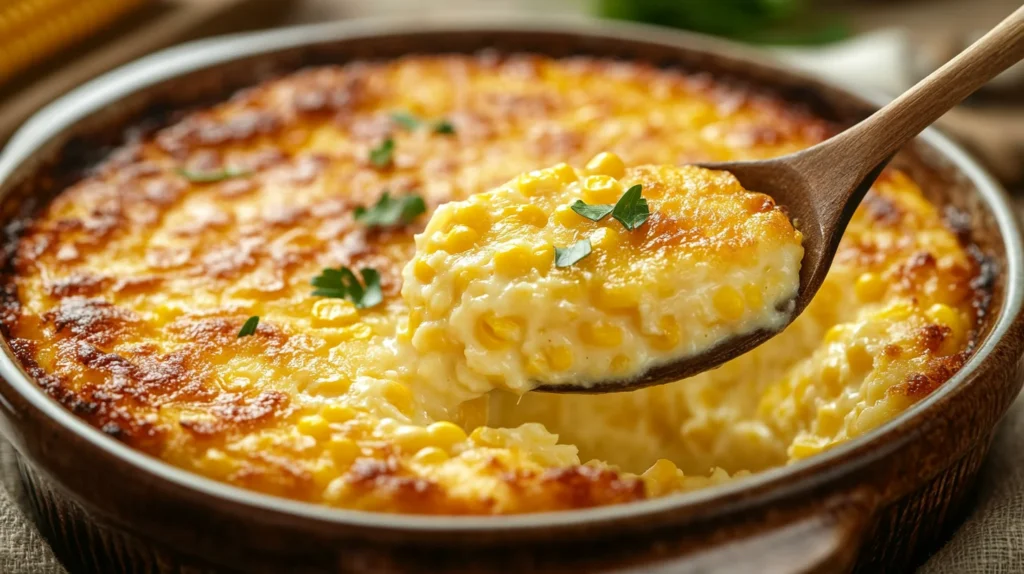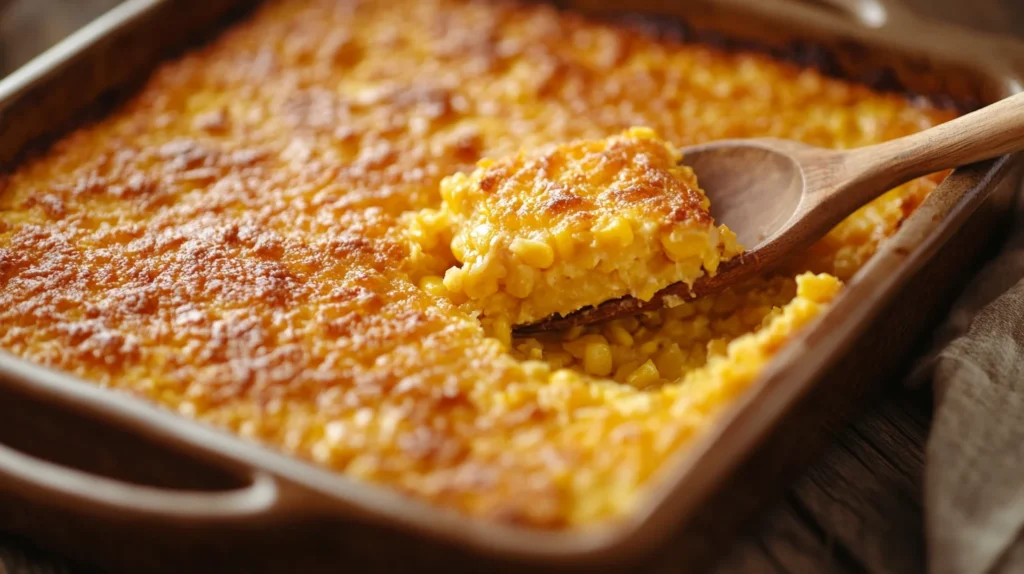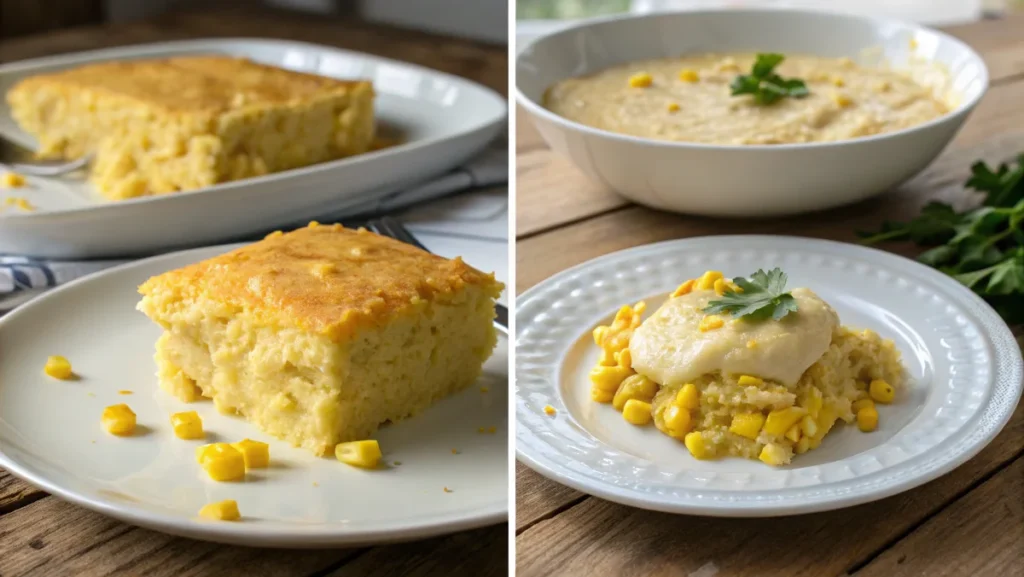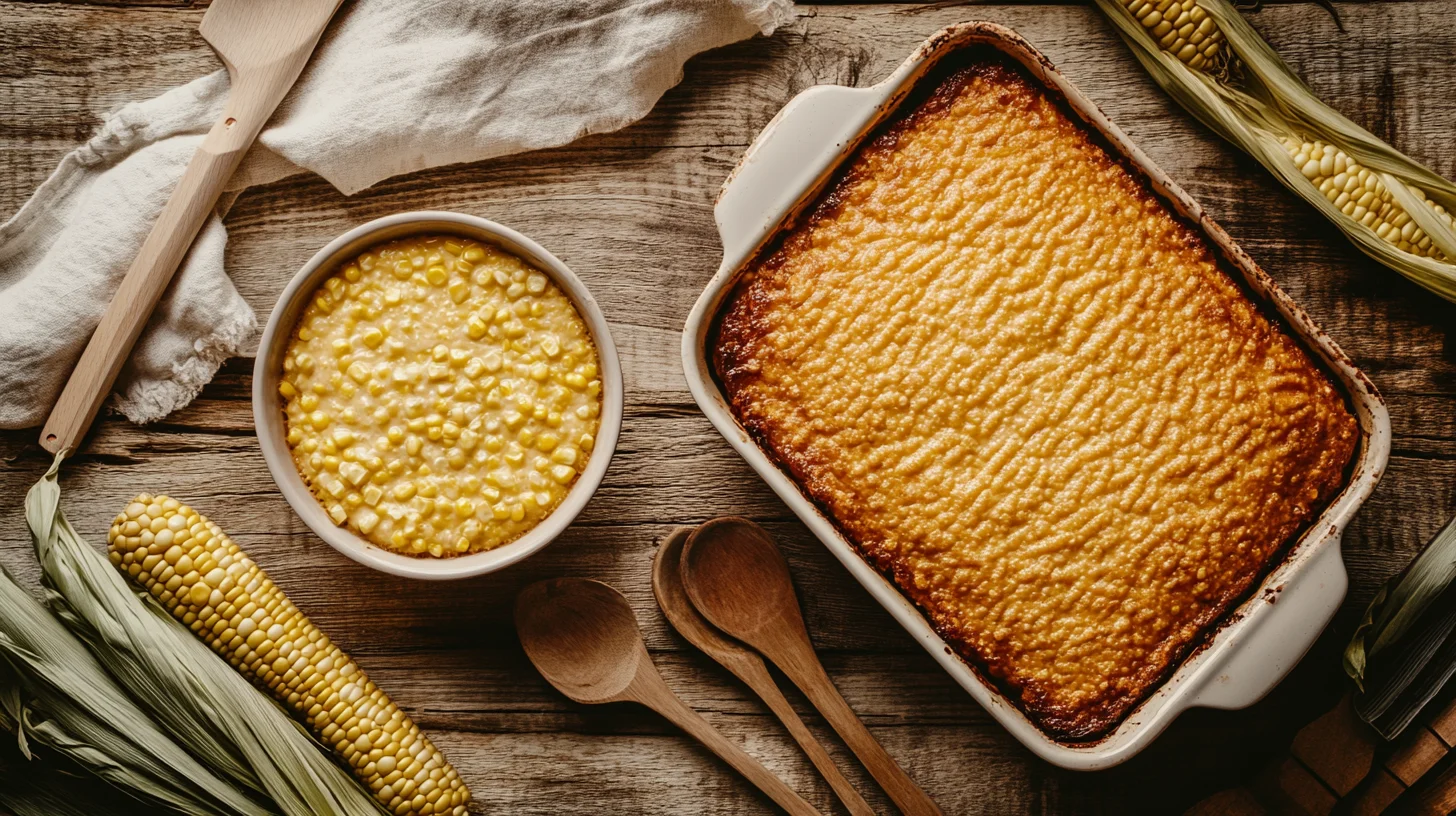When it comes to comfort food, few dishes evoke nostalgia and warmth like Corn Casserole and Corn Pudding. These two corn-based staples often grace tables during family gatherings, holidays, and potlucks. While they share a common ingredient—corn—their textures, flavors, and preparations set them apart. In this article, we’ll delve into the origins, ingredients, and unique qualities of Corn Casserole and Corn Pudding to help you understand their delicious differences. For those interested in mastering the perfect version of this beloved dish, explore Corn Pudding Recipe: The Ultimate Guide to a Perfectly Irresistible Dish.
Table of Contents
What is Corn Pudding?
– Origins and History
Corn pudding has its roots in Southern cooking and is heavily influenced by Native American and early colonial cuisine. Corn, being a staple crop in the Americas, was combined with milk, eggs, and sweeteners to create a dish that balanced sweetness and savoriness. Over time, corn pudding evolved into a holiday favorite, especially in the Southern United States.
– Key Ingredients
The simplicity of corn pudding is one of its defining features. Its ingredients typically include:
- Fresh, canned, or frozen whole kernel corn
- Milk or cream
- Eggs
- Sugar
- Butter
- Flour or cornstarch for thickening
Some variations might add spices like nutmeg or cinnamon for a hint of warmth.
– Texture and Flavor Profile
Corn pudding is known for its smooth, custard-like texture. It has a subtle sweetness that makes it versatile enough to be served as a side dish or even as a dessert in some households. The dish’s creamy consistency is achieved by the combination of eggs and milk, which form a delicate custard when baked. If you’re exploring other versatile and delicious options for mealtime, consider learning more about chicken tacos for a savory twist.

What is Corn Casserole?
– Origins and Popularity
Unlike corn pudding, corn casserole is a more modern dish, popularized in the mid-20th century. It became widely recognized as a quick and easy comfort food, often associated with potlucks and holiday meals. Its introduction coincided with the rise of convenience foods, as boxed mixes and canned goods became household staples.
– Key Ingredients
The hallmark of corn casserole is its use of a pre-made corn muffin mix, such as Jiffy. Its ingredients typically include:
- Jiffy corn muffin mix
- Canned creamed corn
- Canned whole kernel corn, drained
- Sour cream
- Butter
Optional additions like shredded cheese, diced jalapeños, or crumbled bacon can elevate the dish and add layers of flavor.
– Texture and Flavor Profile
Corn casserole has a hearty, bread-like consistency that contrasts sharply with the creamy texture of corn pudding. The muffin mix gives it a slightly crumbly, cake-like texture, while the combination of creamed corn and butter ensures it stays moist. The dish is more savory than sweet, with a touch of natural sweetness from the corn.

Key Differences Between Corn Pudding and Corn Casserole
– Base Ingredients
One of the main differences lies in the base ingredients. Corn pudding relies on a custard base made from eggs and milk, whereas corn casserole depends on a corn muffin mix as its foundation. This distinction significantly impacts the texture and flavor of each dish.
- Corn Pudding: Primarily uses milk, eggs, and sugar for a creamy custard.
- Corn Casserole: Incorporates Jiffy mix for a denser, bread-like texture.
– Sweet vs. Savory
Another critical difference is the balance of sweetness and savoriness. Corn pudding leans sweeter due to the added sugar and its custard base, while corn casserole is more savory, often incorporating sour cream, butter, and optional savory additions like cheese or jalapeños.
– Texture Comparison
The texture is perhaps the most noticeable difference between the two dishes:
- Corn Pudding: Smooth, creamy, and soft. It’s more delicate and resembles a dessert custard.
- Corn Casserole: Dense, moist, and crumbly with a golden crust, akin to a bread pudding.
– Cooking Styles
Corn pudding is usually baked until the custard sets, resulting in a creamy, silky dish. On the other hand, corn casserole is baked until it develops a firm structure with a slightly crispy top.
– Occasion and Serving Suggestions
Corn pudding often serves as a sweeter side dish and pairs well with savory mains like roasted turkey or ham. Corn casserole, being heartier and more savory, is commonly served alongside barbecue, chili, or other robust dishes. When planning meals with similarly indulgent dishes, understanding portion sizes is essential—learn more about how much Beef Wellington per person to ensure you serve just the right amount.

Preparation Techniques for Corn Pudding
– Ingredients and Tools Needed
Making corn pudding requires a few simple tools and ingredients. Gather a mixing bowl, whisk, baking dish, and these key ingredients:
- 2 cups of corn
- 2 large eggs
- 1 cup of milk
- 1/3 cup of sugar
- 2 tablespoons of melted butter
- 1 tablespoon of flour (optional, for thickening)
– Step-by-Step Instructions
- Preheat the oven: Set your oven to 350°F (175°C) and grease a baking dish.
- Mix the wet ingredients: In a mixing bowl, whisk together eggs, milk, and sugar until smooth.
- Add the corn: Fold in the corn (either fresh, frozen, or canned) and melted butter.
- Optional thickening: If you prefer a slightly firmer pudding, whisk in a tablespoon of flour or cornstarch.
- Bake: Pour the mixture into the greased baking dish and bake for 40–45 minutes or until the custard is set.
– Serving Tips
Let the pudding cool slightly before serving. It pairs well with roasted meats and other traditional holiday sides like green beans or mashed potatoes.
Preparation Techniques for Corn Casserole
– Ingredients and Tools Needed
Corn casserole requires a little more assembly but is equally straightforward. Gather a mixing bowl, spatula, and these key ingredients:
- 1 box of Jiffy corn muffin mix
- 1 can of creamed corn
- 1 can of whole kernel corn (drained)
- 1 cup of sour cream
- 1/2 cup of melted butter
– Step-by-Step Instructions
- Preheat the oven: Heat your oven to 350°F (175°C) and grease a baking dish.
- Combine the ingredients: In a mixing bowl, combine the corn muffin mix, creamed corn, whole kernel corn, sour cream, and melted butter. Mix until fully incorporated.
- Optional additions: Add shredded cheese or diced jalapeños for extra flavor.
- Bake: Pour the mixture into the greased dish and bake for 45–50 minutes or until the top is golden brown and firm.
– Serving Tips
Allow the casserole to rest for 5–10 minutes before serving to ensure it sets. It pairs wonderfully with savory dishes like pulled beef, grilled chicken, or chili.
Nutritional Comparison: Corn Pudding vs. Corn Casserole
– Calories and Macronutrients
Corn pudding and corn casserole differ significantly in their nutritional profiles due to their ingredients.
- Corn Pudding:
- Higher in sugar due to added sweeteners.
- Contains moderate fats from milk, butter, and eggs.
- Fewer carbohydrates compared to corn casserole.
- Corn Casserole:
- Contains more carbs due to the corn muffin mix.
- Higher fat content because of butter and sour cream.
- Generally less sweet, depending on optional added sugar.
– Dietary Considerations
For those watching their caloric intake, corn pudding might be a better choice when made with low-fat milk and minimal sugar. Corn casserole, with its richer ingredients, can be heavier and more indulgent. Both dishes can be adapted for gluten-free or dairy-free diets by swapping out specific ingredients like flour or sour cream. For a similarly customizable yet elegant dish, consider exploring individual Beef Wellington for a sophisticated and portion-controlled option.
Which Dish Suits Your Occasion?
– Corn Pudding for Special Events
Corn pudding’s sweet, custard-like nature makes it a perfect complement to savory dishes like roasted turkey or ham. Its rich texture also makes it an excellent addition to holiday spreads, balancing out heavier sides like stuffing or mashed potatoes.
– Corn Casserole for Everyday Meals
Corn casserole’s heartiness makes it ideal for casual gatherings, barbecues, or weeknight dinners. It pairs beautifully with grilled meats, chili, or any dish requiring a more substantial side.
– Versatility and Customization
Both dishes can be adapted to suit your preferences. Want a spicier version? Add jalapeños or cayenne pepper. Craving something sweeter? Add a touch of honey or cinnamon.
Side-by-Side Comparison Table
| Feature | Corn Pudding | Corn Casserole |
|---|---|---|
| Texture | Creamy and custard-like | Dense and bread-like |
| Flavor | Sweet and subtle | Savory with a hint of sweetness |
| Main Ingredients | Eggs, milk, sugar, corn | Jiffy mix, creamed corn, sour cream |
| Best Pairings | Roasted turkey, ham | Barbecue, chili, grilled chicken |
| Dietary Options | Easily made gluten-free | Gluten-free with substitute mix |
FAQs About Corn Pudding and Corn Casserole
1. What is the difference between corn casserole and corn pudding?
The difference between corn casserole and corn pudding lies in their texture, ingredients, and flavor profiles, making them distinct dishes despite their shared base of corn.
- Corn Casserole:
Corn casserole is a savory, hearty side dish that combines Jiffy corn muffin mix with canned creamed corn, sour cream, and butter. It has a dense, bread-like consistency with a slightly crumbly texture. The flavor leans savory, although the natural sweetness of the corn and the muffin mix adds a subtle sugary note. Additions like cheese, jalapeños, or bacon are common to enhance its richness and depth. - Corn Pudding:
Corn pudding, on the other hand, is a sweet, custard-like dish. Made from eggs, milk or cream, sugar, and corn, its creamy texture and subtle sweetness give it a dessert-like quality. The lack of a muffin mix means corn pudding remains soft and smooth throughout, making it a lighter dish that pairs well with savory entrees.
Key Takeaway: Corn casserole feels more like a hybrid of cornbread and pudding, while corn pudding is purely custard-based.
2. What is the difference between cornbread and cornbread casserole?
Although they share some ingredients, cornbread and cornbread casserole differ in preparation and texture.
- Cornbread:
Cornbread is a traditional quick bread made from cornmeal, flour, eggs, milk, and baking powder. It’s baked until firm and has a crumbly, slightly dry texture that’s perfect for soaking up soups, stews, or gravies. Classic cornbread is mildly sweet or entirely savory, depending on regional variations. - Cornbread Casserole:
Cornbread casserole is richer and moister, thanks to the addition of creamed corn, sour cream, and butter. The texture is softer, almost cake-like, and it’s often served with savory toppings like chili or pulled beef. Think of cornbread casserole as the indulgent cousin of cornbread—ideal for holiday tables or as a comforting side dish.
Key Takeaway: Cornbread is firm and crumbly, while cornbread casserole is moist and creamy with added layers of flavor.
3. Why is corn pudding called pudding?
The term “pudding” in corn pudding is rooted in its soft, custard-like consistency. Historically, the word “pudding” referred to a broad category of dishes with a creamy or soft texture, often thickened with eggs or flour.
In the case of corn pudding:
- Eggs and milk or cream act as binding agents, forming a custard when baked.
- The result is a smooth, rich texture reminiscent of dessert puddings, though corn pudding is often served as a side dish.
The sweetness of corn pudding also aligns it with the historical concept of a pudding, where sweetness played a key role in distinguishing the dish. While it can function as a side, some variations, like those with added nutmeg or cinnamon, make it closer to a dessert.
Key Takeaway: Corn pudding is called pudding due to its creamy, custard-like texture and slightly sweet flavor, aligning with traditional pudding definitions.
4. What can I substitute for sour cream in corn casserole?
If sour cream is unavailable or if you’re looking for an alternative due to dietary restrictions, there are several substitutes that maintain the creaminess and tangy flavor needed for corn casserole:
- Greek Yogurt:
- Use plain, full-fat Greek yogurt as a 1:1 replacement.
- It has a similar tangy flavor and creamy consistency.
- Bonus: It’s higher in protein and lower in fat, making it a healthier option.
- Cream Cheese (Softened):
- Blend softened cream cheese with a splash of milk to mimic the texture of sour cream.
- This option adds a rich, slightly tangy flavor.
- Buttermilk:
- Use buttermilk as a substitute, though its thinner consistency may require an adjustment in the recipe (reduce other liquids).
- It adds a mild tang and keeps the dish moist.
- Dairy-Free Alternatives:
- Use coconut cream, cashew cream, or a plant-based yogurt if you’re aiming for a dairy-free option.
- These alternatives provide creaminess without compromising texture.
- Mayonnaise:
- While unconventional, mayonnaise works well in a pinch, adding moisture and a mild tang to the dish.
Key Takeaway: The best substitute for sour cream in corn casserole depends on your dietary preferences, but Greek yogurt, cream cheese, or a dairy-free option can replicate its creamy tang effectively.
Conclusion
Corn pudding and corn casserole are both delightful dishes that cater to different tastes and occasions. Corn pudding shines as a sweet, creamy side dish that complements savory entrees beautifully. Its smooth, custard-like texture makes it a comforting option for festive meals.
On the other hand, corn casserole is hearty and savory, with a bread-like consistency that pairs perfectly with robust dishes like chili or barbecue. Its use of Jiffy mix creates a simple yet satisfying dish that’s easy to customize with add-ins like cheese or jalapeños.
Whether you prefer the subtle sweetness of corn pudding or the rich savoriness of corn casserole, both dishes are versatile and easy to prepare. For an intriguing Southern culinary pairing, you might also wonder is chicken and waffles a Georgia thing? Explore the origins of this iconic dish as you plan your next gathering.

